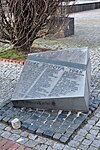Memorial Route of Jewish Martyrdom and Struggle, Warsaw
1988 establishments in Poland1988 sculpturesHolocaust memorials in PolandJewish history stubsMonuments and memorials in Warsaw ... and 2 more
Poland stubsWarsaw Ghetto

The Memorial Route of Jewish Martyrdom and Struggle in Warsaw is located the Muranów district to commemorate people, events and places of the Warsaw Ghetto during the German occupation of Poland. The memorial route begins at the Warsaw Ghetto Monument in the corner of ul. Zamenhofa and ul. Anielewicza and leads the visitor along a path of markers ending at the ul. Stawki near the Umschlagplatz Monument.
Excerpt from the Wikipedia article Memorial Route of Jewish Martyrdom and Struggle, Warsaw (License: CC BY-SA 3.0, Authors, Images).Memorial Route of Jewish Martyrdom and Struggle, Warsaw
Ludwika Zamenhofa, Warsaw Śródmieście (Warsaw)
Geographical coordinates (GPS) Address Nearby Places Show on map
Geographical coordinates (GPS)
| Latitude | Longitude |
|---|---|
| N 52.249108 ° | E 20.995101 ° |
Address
Ludwika Zamenhofa
Ludwika Zamenhofa
00-157 Warsaw, Śródmieście (Warsaw)
Masovian Voivodeship, Poland
Open on Google Maps










